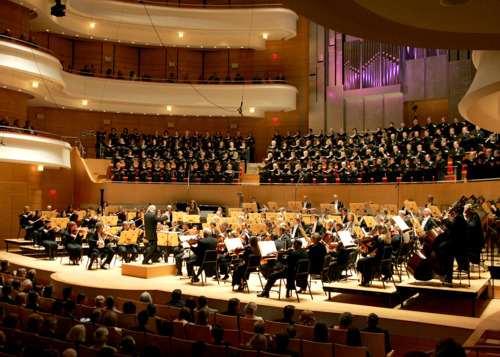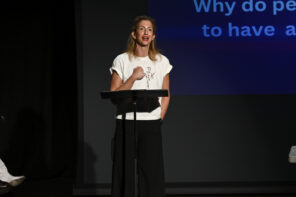Pacific Symphony Orchestra
by Tyler Dean
Yang a tempestuous fireball of pianistic lyricisms
A rousing performance from start to finish, the 35th Anniversary of the Pacific Symphony Orchestra segues into the pre-holiday season with an eclecticism of pieces as profoundly intuitive as they are performed. Led by Music Director Carl St. Clair, the players outdo themselves once more as they partake in transformative renditions of, first, the overture to the folktale odyssey, Russlan and Ludmilla, then finishing the evening off with Béla Bartók’s Concerto for Orchestra. However, it’s a fact (well, depending on who you ask) that if you really want to hit the proverbial nail on the head when it comes to classicist grandstanding, you need look no further than the beloved—and oft-referenced—Tchaikovsky poesy, Piano Concerto no. 1, performed tonight by the gracefully fierce guest artist, Joyce Yang. In a production as equally “altogether everywhere” as its conductor, the only truth more fully realized is that tonight will surely be unforgettable.
No matter who you are, there is always that one musical number which will always serve to invigorate even the creakiest of bones and lackadaisical of dispositions, a theme to which our feet cannot help but want to sprint across open fields, take on adventure, and slay the dragon within. Everyone has their preferences, but I’m here to tell you that you’ve heard nothing until you bear witness to the power and enterprising mysticism of Mikhail Glinka’s Overture to Russlan and Ludmilla. From the opening cords it is a race to the finish, the Pacific Symphony masterfully commands bow and string, lungs and horn, to ceremoniously throw down the gauntlet of what has to be the first piece that has made me want to live out my childhood Zelda fantasies since the first moment I heard Kōji Kondō’s original theme.
I wouldn’t be far off from its original purpose; the overture, which combines elements of European operatic style with eastern European and Russian folk melodies, was intended to capture the overall spirit of its namesake production, the story about three suitors who set out on a journey to save the princess Ludmilla from dark forces. Even if I hadn’t read the program, the symphony does such a wonderful job of conjuring up the ephemeral quasi-Grimm Fairy Tale/Disney qualities of a boisterous odyssey that the effect would nevertheless be similar. Perhaps the only experience equally bracing is that of tonight’s Maestro, Carl St. Clair, and his trademark ferocity dancing across the conductor’s platform.
Indeed, the overture appropriately precedes that of the headlining performance: Piotr Ilyich Tchaikovsky’s Piano Concerto no. 1. Fun fact, I’ve actually only ever heard this piece played once before, not too long ago at the Irvine Amphitheater when guest pianist Vadym Kholodenko enraptured a sold-out audience with magisterial riffs, his playful tectonic-plate fingers sliding over one another in a seamless ballad of ebony and ivory. It was fun, to be sure, but I’m going to say here and now (and, being somewhat of a novice to classical orchestra criticism, unsure what sort of backlash this may inspire) that the Kholodenko experience was nothing in comparison to the shooting star that is Joyce Yang.
Speaking on the Piano Concerto no. 1, Yang said in a recent interview: “Each movement has drama, grandeur, beauty … all juxtaposed into one great landscape. The orchestra and the soloist often take turns introducing different melodies—revealing different textures and colors to the same melody.” Oscillating between a furious tempest and glass-like serenity, Yang captures the imagination with fingers that seem to melt across the keys in a fluidity not unlike a hummingbird’s wings in the wee hours of sunrise. The conversation that takes place between she and the orchestra can be likened to that of a single organism spewing forth a string of soliloquy’s, perhaps even the very same that filled this piece’s composer.
But it’s the control Yang encapsulates that really brings the concerto to a whole different plane of playability. Out of the entire 34-minute runtime, there is one moment in particular I speak of: somewhere in the second movement (‘andantino semplice’), Yang slows the piece to a crawl, her fingers lingering over the keys in a state of vapid amorality. Softly, that is thoughtfully, she plays one, lets the note reverberate off the walls of the concert hall, then another. This goes on for a several seconds-seems-like-hours (the good kind), where, for a multitude of instants, she is the only being on this planet, existing, consuming oxygen, time, and space. And then she carries on, the orchestra reappears, and segueing into the third movement, we come to the piece’s conclusion and to our feet.
Rounding out the evening is Béla Bartók’s Concerto for Orchestra. Now, for those of you unawares (and if the previous section didn’t give it away), a ‘concerto’ is usually a title reserved for pieces where a single instrument or performer has a solo throughout and is backed by the orchestra. So when you have something similarly titled for Orchestra, it might seem a little backwards. Well, not quite. See, following very successful recognition in Europe in the first half of his career, Bartók’s star power took a slight nosedive in the events leading up to, and during, the second World War. Moving to the states, the lack of public interest and an oncoming bout of leukemia severely depleted the composer’s creative juices. However, as so happens in life, it was during this rock-bottom that a ray of light made itself known: commissioned by Serge Koussevitzky, the music director of the Boston Symphony Orchestra and champion of new music, Bartók set out in the Summer of ’43 to write what would become one of his greatest compositions. It was a hit.
The question still remains, why a concerto for orchestra? You could call it ingenuity, or maybe a moment of lucidity poking through the cloudy remains of a world at war, but I personally like to think that Bartók felt that 1943 was no time for incongruence or focus on the individual, but an era of united fronts, of coming together to overcome the “satanic forces” of the world at that time (in the latter case, the Axis powers).
The Concerto for Orchestra is one which articulates an emotional character arc undoubtedly held by many fleeing Nazi Germany and its allies. Weaving the tears and fears of these people with an overflowing and ominous uncertainty, the orchestra opens our senses in the first movement with what is referred to as ‘Night music’—lingering notes, soft punctuations of “critters” and “creatures” hiding in the dark, the unknown. It isn’t until the second movement—dubbed the ‘Game of Pairs’—that we see the first telltale signs of a people coming together, standing up to be heard. Ignited by the sound of a drum beating out a monotonous rhythm, pairs of instruments (the bassoons and the oboes, clarinets and flutes) collide over our heads in lilting intonations and grooves that warm the heart and inspire the spirit. A solid juxtaposition, the orchestra transitions with a practiced temper.
Finally, in the fifth movement the orchestra comes together in an eruption of escalating, repetitive scales in the style of ‘perpetuum mobile’, or perpetual motion. Marked ‘presto’, this end note on an otherwise muted conflagration forces the orchestra to move in their efforts to keep up with Bartók. So much so, in fact, that I noticed there were more than a few players who could easily rival St. Clair’s manic hopscotch conducting style. It is a memorable performance, one which leaves on the audience member an indelible impression of hope, solidarity, and maybe even a little magic.
Blessed with “poetic and sensitive pianism” (Washington Post) and a “wondrous sense of color” (San Francisco Classical Voice), pianist Joyce Yang captivates audiences across the globe with her virtuosity, lyricism and magnetic stage presence. At just 27, she has established herself as one of the leading artists of her generation through her innovative solo recitals and collaborations with the world’s top orchestras. In 2010 she received an Avery Fisher Career Grant, one of classical music’s most prestigious accolades.
For more information regarding Pacific Symphony events or to purchase tickets, call (714) 755-5799 or visit www.PacificSymphony.org
Pacific Symphony, celebrating its 35th season in 2013-14, is led by Music Director Carl St. Clair, who marks his 24th season with the orchestra. The largest orchestra formed in the U.S. in the last 40 years, the Symphony is recognized as an outstanding ensemble making strides on both the national and international scene, as well as in its own community of Orange County. Presenting more than 100 concerts a year and a rich array of education and community programs, the Symphony reaches more than 275,000 residents—from school children to senior citizens.
This post has been brought to you by our friends at:
Follow ATOD Magazine™






